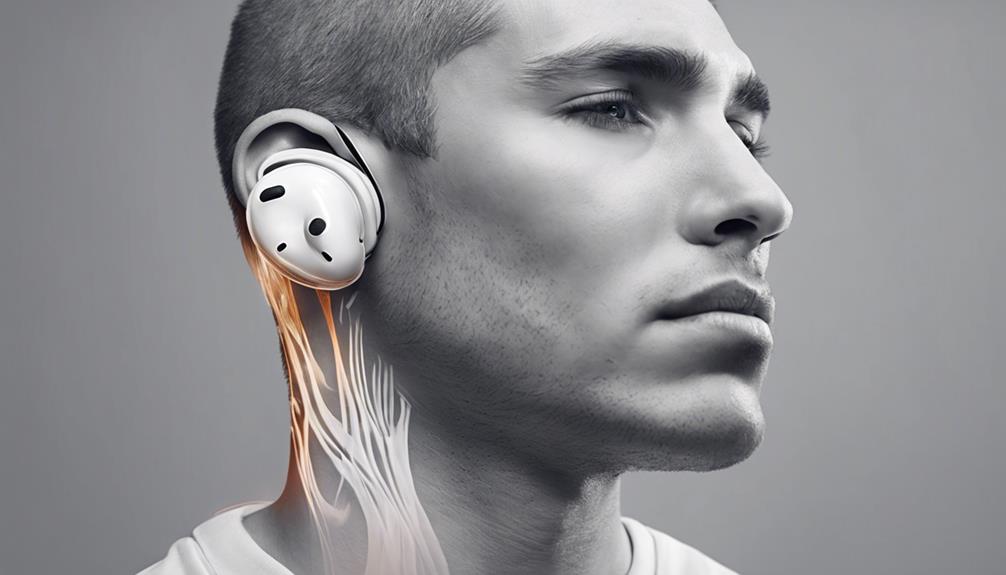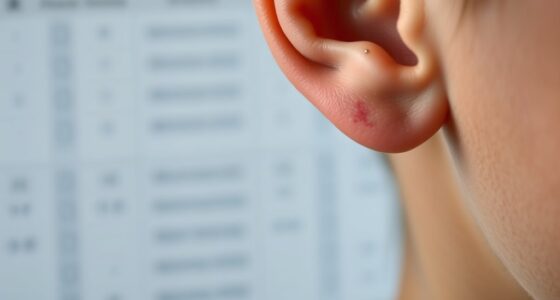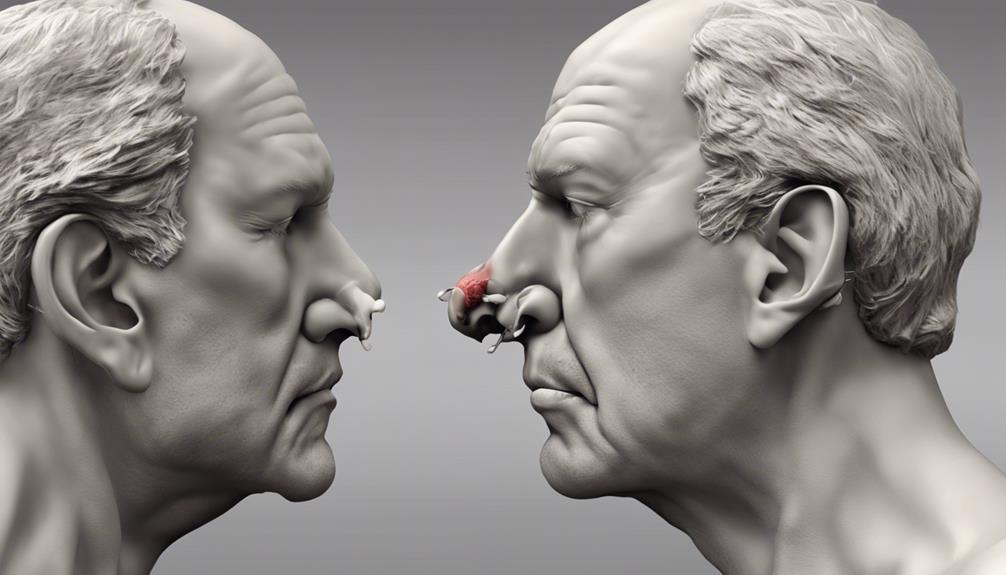Let’s explore the idea that **AirPods**, those tiny marvels of modern technology, might be causing more harm than we realized. Find out why you might want to reconsider their usage.
From the convenience they offer to the potential risks they carry, our reliance on these wireless earbuds could be impacting our hearing in ways we never imagined.
But before you dismiss this as just another cautionary tale, let's explore the intricate relationship between AirPods and permanent hearing loss, and why understanding these nuances is crucial for our auditory well-being.
Key Takeaways
- Prolonged AirPods use at high volumes can lead to irreversible hearing damage.
- Following safe listening practices like the 60/60 Rule is crucial.
- Awareness of volume levels and duration is essential for preventing permanent harm.
- Regular maintenance, breaks, and volume adjustment help protect against hearing loss.
Understanding AirPods' Impact on Hearing
The impact of AirPods on hearing is a critical concern due to the potential for permanent damage from prolonged exposure to high decibel levels. AirPods, with their design that creates a seal in the ear canal, can deliver sound waves directly to the eardrum, increasing the risk of damage to the sensitive inner ear hair cells. Studies indicate that AirPods can produce volumes exceeding 100 dB, which surpasses safe listening levels and poses a significant threat to hearing health. Exposing oneself to such high decibel levels for extended periods can result in irreversible harm, leading to permanent hearing loss.
To mitigate the risks associated with AirPods, it's crucial to adhere to safe listening practices. This includes keeping the volume at a moderate level, taking regular breaks during extended listening sessions, and being mindful of the duration of exposure to high volumes. By understanding the potential for damage that AirPods can cause and implementing these safe practices, individuals can better protect their hearing health in the long term.
Risks of Prolonged High-Volume Listening

Excessive exposure to high volumes through AirPods poses a significant risk to auditory health, potentially leading to irreversible damage over time. When considering the risks of prolonged high-volume listening habits with AirPods, it's crucial to understand the potential consequences:
- Permanent Hearing Damage: Listening at high volumes can cause permanent damage to the delicate hair cells in the cochlea, leading to irreversible hearing impairment.
- Increased Risk of Tinnitus: Prolonged exposure to unsafe volume levels from AirPods can result in tinnitus, a persistent ringing in the ears that can be disruptive and distressing.
- Damage to Auditory Nerve: Consistent high-volume usage of AirPods can lead to damage of the auditory nerve, potentially causing long-term hearing issues.
It is essential to be mindful of volume levels when using AirPods to prevent harm to your auditory system. Understanding the risks associated with high-volume listening is crucial in preserving your hearing health and preventing permanent damage.
Science Behind AirPods and Hearing Loss
After prolonged exposure to high volumes from AirPods, the risk of hearing loss increases significantly due to the sound levels exceeding 100 dB. This excessive noise can damage the delicate structures within the inner ear, specifically the hair cells responsible for converting sound vibrations into electrical signals that are transmitted to the brain via the auditory nerves.
The design of AirPods, which creates a seal in the ear canal, can further intensify sound waves, potentially leading to irreversible harm. Symptoms such as tinnitus, a ringing or buzzing in the ears, may indicate ear damage caused by extended AirPod usage.
Understanding the science behind how AirPods can cause hearing loss is vital in taking proactive measures to prevent permanent damage to the auditory system. By being aware of the potential risks associated with high sound levels and taking steps to limit exposure, individuals can safeguard their hearing health and maintain auditory function in the long term.
Practical Tips for Ear Protection

Exploring practical strategies for effectively safeguarding our ears from potential damage caused by prolonged AirPod usage involves implementing specific measures to regulate volume levels and duration of exposure. To protect our hearing health while using AirPods, consider the following tips:
- Follow the 60/60 Rule: Keep the volume of your AirPods at 60% of the maximum volume and limit your listening time to 60 minutes continuously. Adhering to this rule can significantly reduce the risk of permanent hearing loss.
- Be Mindful of Background Noise: High levels of background noise can trick you into increasing the volume of your AirPods to unsafe levels. Try to use noise-canceling features or find quieter environments to listen to your favorite tunes.
- Regular Monitoring and Adjusting: Continuously monitor the volume levels of your AirPods and ensure they stay within the safe range of 60-70 dB. Adjust the volume as needed to protect your ears from excessive noise exposure.
Preventing Permanent Hearing Damage
To prevent permanent hearing damage from AirPod usage, it is crucial to adhere to recommended volume levels and duration limits. The World Health Organization recommends limiting continuous listening to no more than 60 minutes at a time to reduce the risk of permanent hearing loss. Clinical audiologists suggest using noise-canceling features on Apple AirPods to block external sounds, which can help lower the need for high volume levels that could damage the ear canal. Regularly cleaning AirPods is essential to prevent ear infections and maintain optimal sound quality for safer usage. Adjusting volume settings to stay within the safe listening range of 60-70 decibels is crucial for protecting against permanent hearing damage. Additionally, taking breaks from listening can help prevent long-term harm to your ears. Remember, being mindful of how loud noises and prolonged exposure affect your hearing is key to preserving your auditory health.
| Prevention Tips | Benefits |
|---|---|
| Limit listening to 60 minutes | Reduce risk of permanent hearing loss |
| Use noise-canceling features | Lower need for high volume levels and protect ear canal |
| Clean AirPods regularly | Prevent ear infections and maintain optimal sound quality |
| Adjust volume settings | Stay within safe listening range of 60-70 decibels |
| Take breaks from listening | Prevent long-term damage to your ears |
Frequently Asked Questions
Do Airpods Cause Permanent Hearing Loss?
Yes, AirPods can cause permanent hearing loss. Prolonged exposure to high volumes from AirPods can damage delicate inner ear cells, leading to irreversible hearing damage.
Studies show that AirPods emit sound levels exceeding 100 dB, contributing to potential hearing loss. To prevent this, it's crucial to take breaks and limit volume levels while using AirPods.
Protecting our hearing is essential to maintaining long-term auditory health.
What Happens if You Wear Airpods for Too Long?
If we wear AirPods for too long, we risk damaging our hearing. Prolonged exposure to high sound levels can harm delicate inner ear structures, like hair cells, potentially leading to irreversible hearing loss. Continuous use at high volumes may also increase the likelihood of developing tinnitus, a persistent ringing in the ears.
To safeguard our hearing health, it's essential to take breaks and limit our AirPods usage to prevent long-term inner ear damage.
Can Airpods Noise Cancelling Damage Hearing?
Yes, AirPods' noise-canceling features can potentially damage hearing if misused. These features block external sounds, leading users to increase the volume unknowingly. This can expose the inner ear to harmful noise levels.
However, when used correctly, noise-canceling technology aids in maintaining safe listening levels, reducing the risk of hearing damage. Properly utilizing these features is crucial in safeguarding our auditory health and preventing long-term hearing loss.
Can Airpod Pros Cause Ear Infections?
Yes, AirPod Pros can potentially cause ear infections. Prolonged use of these devices can lead to increased moisture in the ear canal, creating an environment where bacteria can thrive. If not properly sanitized, AirPods can introduce bacteria to the ear, leading to infections.
Symptoms may include pain, itching, discharge, and temporary hearing loss. Regular cleaning and avoiding sharing AirPods can help reduce the risk of developing ear infections.
Conclusion
In conclusion, let's remember that our ears are delicate instruments that deserve our care and attention. Just as we wouldn't expose a fragile flower to harsh elements, we should treat our hearing with the same level of care.
By being mindful of our AirPods usage and taking proactive steps to protect our ears, we can ensure that the symphony of sound in our lives continues to play harmoniously for years to come.











